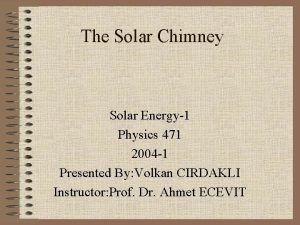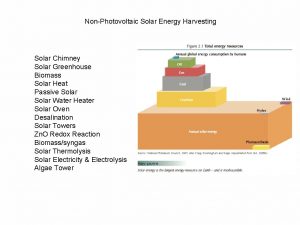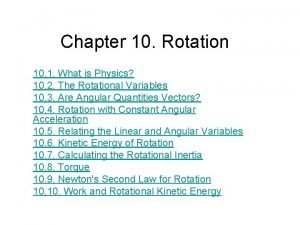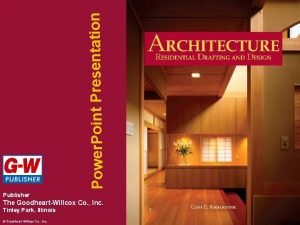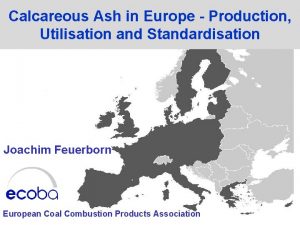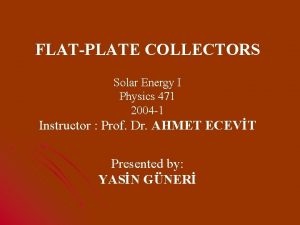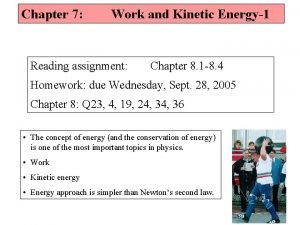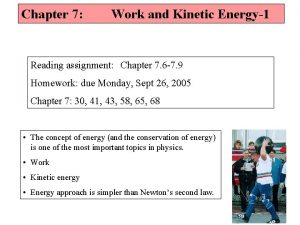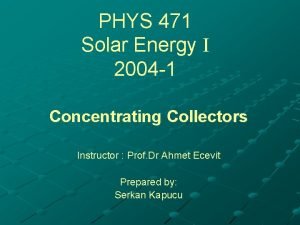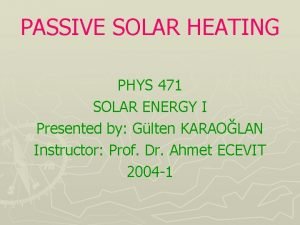The Solar Chimney Solar Energy1 Physics 471 2004











![Fig. 5 Turbine with large diameter [5]. Fig. 6 Small turbines [5]. Fig. 5 Turbine with large diameter [5]. Fig. 6 Small turbines [5].](https://slidetodoc.com/presentation_image_h/9a9a1df4f2ff439f48a9bc67a6f10941/image-12.jpg)



![Fig. 8 Free-standing [5]. Fig. 9 Guyed Tubes [5]. Fig. 8 Free-standing [5]. Fig. 9 Guyed Tubes [5].](https://slidetodoc.com/presentation_image_h/9a9a1df4f2ff439f48a9bc67a6f10941/image-16.jpg)





















- Slides: 37

The Solar Chimney Solar Energy-1 Physics 471 2004 -1 Presented By: Volkan CIRDAKLI Instructor: Prof. Dr. Ahmet ECEVIT

Contents: 1. 2. Introduction The Solar Chimney a. Parts of the Solar Chimney i. Collector ii. Turbines iii. Chimney b. c. 3. 4. 5. Working Principles of Solar Chimney Technology The Energy Storage In the Collector Cost The Mildura Solar Chimney

Contents: 6. Advantages 7. Disadvantages 8. Conclusion References

1. Introduction: In many parts of the world, there is a growing awareness that some alternative energy sources could have an important role to play in the production of electricity. However, only the solar energy represents totally nonpolluting inexhaustible energy resource that can be utilized economically to supply Man’s energy needs for all time [1].

There are lots of methods of using the solar energy , and the Solar Chimney is one of them, which can be seen below, in figure 1. Fig. 1 The Prototype Manzanares Solar Chimney [2].

2. The Solar Chimney In 1978, it was suggested by Professor Schlaich of Stuttgart university that power could be produced by a hybrid solar system [3]. The solar chimney system consists of three parts; The collector, turbines and the chimney.

2. a. Parts of the Solar Chimney 2. a. i. The Collector is the part, which is used to produce hot air by green-house effect. It is usually 5 -6 meters high and covers a very large area about thousands of m² as seen in fıgure 2. Collector Fig. 2 The Collector [2].

Since glazing increases the mass of the roof, glazed collectors should have stronger rods and should be attached as in figure 3. Fig. 3 The glazed collector roof of Solar Chimney [4].

• There is no limitation for the surface area. The larger the area, the more energy generated from the chimney. • There should be slightly increasing height towards to the chimney in order to obtain minimum friction loss. • Covering materials may be different, such as; glass, plastic film or glazed collector. The most efficient one is glazed collector. It can convert up to 70% of irratiated solar energy into heat a typical annual average is 50%. Also, with proper maintenance, its life span can easily be 60 years or more.

2. a. ii. Turbines, seen in figure 4, are used to convert air current to the mechanical energy. Fig. 4 Turbine for Solar Chimney Power Station [2].

Turbines are placed horizontally in chimney, vertically in the collector. In order to obtain maximum energy from the warmed air, turbines blades should cover all the cross-sectional area of the chimney. To do this, one big turbine or a few small turbines should be used in chimney, as can be seen from the figure 5. and figure 6.
![Fig 5 Turbine with large diameter 5 Fig 6 Small turbines 5 Fig. 5 Turbine with large diameter [5]. Fig. 6 Small turbines [5].](https://slidetodoc.com/presentation_image_h/9a9a1df4f2ff439f48a9bc67a6f10941/image-12.jpg)
Fig. 5 Turbine with large diameter [5]. Fig. 6 Small turbines [5].

2. a. iii. The chimney The most important part of the plant is the chimney, seen in fıgure 7. It acts as a thermal engine. Since the friction loss is minimum in the chimney it likes a Fig. 7 The chimney [2]. pressure tube. Chimney

• Longer the chimneys height, the more the energy produced from the chimney. • The efficiency of the chimney is not depend on the amount of the temperature rising, but depends on the outside temperature. Thus, efficiency directly proportional to the ratio between the height of the chimney and the outside temperature. [5]

Although, the efficiency is proportional to the height of the chimney, there is a limitation in practice. There are two types of different chimneys using for the plant. Free standing chimneys and guyed tubes (Figure 8. and figure 9. ). The life span of a free standing chimney is longer than that of the guyed tubes. It lasts about a hundred years, while the guyed tubes’ is much shorter.
![Fig 8 Freestanding 5 Fig 9 Guyed Tubes 5 Fig. 8 Free-standing [5]. Fig. 9 Guyed Tubes [5].](https://slidetodoc.com/presentation_image_h/9a9a1df4f2ff439f48a9bc67a6f10941/image-16.jpg)
Fig. 8 Free-standing [5]. Fig. 9 Guyed Tubes [5].

2. b. Working principles of Solar Chimney Transparent roof, which is seen in fıgure 10, admits the short wave solar radiation component and retains longwave radiation from the heated ground. Thus, when solar radiation pass through the transparent roof it is absorbed by the ground elements and it converts into heat energy. Fig. 10 Transparent roof [4].

• Since air is heated, it starts to rise up and move towards to chimney, seen in fıgure 11. Also, it gains velocity. • Heated air enters the chimney placed at the center of the roof and creates an up draught there. Fig. 11 Schematic seen of the solar chimney [6] • Inside the chimney, turbines with electric generator, produce electricity [6].

Collector Efficiency Heat Output Collector Area Solar Radiation The temperature differences between the collector and out flow Mass flow Chimney cross-section area Specific heat capacity of the air Air speed at collector outflow Specific dendsity of air at temperature To + ΔT at collector outflow

üComparing with the collector and turbine, the chimney efficiency is relativelly low. For example, at a height of 1000 meters, chimney efficiency is somewhat greater than 3% [5]. So, Why use a pipe or air channel to enclose the turbines? Why not have a large "wind farm, " with turbines mounted on towers in the open air? ,

Answer: First, the wind turbines enclosed in a pipe can produce 8 times as much power for a given wind speed than a turbine in the open air. Second, the wind farm concept would require a much larger number of turbines. Also, the wind speed in the open air around the collector is significantly less than the air velocity through the air channel [7].

2. c. Technology • Solar chimneys are large-scale power plants with an output of 5 to 200 MW each [4]. • A 100 MW plant will produce about 750 GWh/year at 2. 300 k. Wh/m² global horizontal radiation [4]. • For that the glass roof has to be several kilometers in diameter and the tube has to be as high as possible to achieve a large annual output [4].

• The turbines are basically more closely related to the pressure-staged hydroelectric turbines than to the speed-stepped wind turbines. Therefore they have been developed and designed in collaboration with hydroelectric power plant manufacturers [4]. • The turbine’s life span is based on its resistance to rapid pressure and speed changes of the air [5].

3. The Energy Storage In the Collector Since collectors produce hot air by green house effect, to produce electric during the night, tight water-filled tubes are placed under the roof, as seen in fıgure 12. [6]. Day Night Fig. 12 Principle of heat storage underneath the roof using water-filled black tubes [6].

• The water heats up during the daytime and emits heat at night. • These tubes are filled only once, no further water is needed, because the tubes remain closed after filling process. • The volume of water in the tubes is selected to correspond to a water layer with a depth of 5 to 20 cm depending on the desired power output [5].

4. Cost “With the support of construction companies, the glass industry and turbine manufacturers a rather exact cost estimate for a 200 MW solar chimney could be compiled. We asked the utility "Energie Baden Württemberg" to determine the energy production costs compared to coal- and combined cycle power plants based on equal and common methods” [8]. (Table. 1).

Table 1. Comparison between the energy production costs of two x 200 MW solar chimneys and 400 MW coal and combined cycle power plants according to the present business managerial calculations [8].

Fig. 13 Energy production costs from solar chimneys, coal and combined cycle power plants depending on the interest rate [8].

5. The Mildura Solar Chimney The 1000 m Solar Chimney in Mildura, Australia, will be the highest man-made structure on Earth, and can produce 200 MW of electricity, providing power to 200, 000 homes. Schematic seen of a construction of a chimney is in figure 14. Fig. 14 Construction of a chimney [2].

• The cost to build the tower is estimated at $395 million. (About 14 percent more than an equivalent coalfired power station, and about 70 percent more per installed megawatt than a comparable wind farm). • The Australian government target of producing 2% of energy from renewable sources by 2010 (9500 Giga. Watt hours) could be met easily[2].

Details of the solar chimney are as follows: Location: Mildura, Australia Type: Solar Tower plant with steelreinforced concrete tower and steel/glass solar air collector (alternatively with polymer glazing) Features: The base of the tower will be between 170 to 200 metres. The chimney is basically a very simple tube with wall thickness of 25 cm, diameter of 150 m and a height of 1000 m. The collector roof will be 5000 m in diameter. Power: Up to 500 Gigawatt hours per year Company: Enviromission Ltd Construction time: About 18 -24 months Expected completion date: 2005 [2].

6. Advantages üSolar chimney power stations are particularly suitable for generating electricity in deserts and sun-rich wasteland. ü It provides electricity 24 hour a day from solar energy alone. üNo fuel is needed. It needs no cooling water and is suitable in extreme drying regions.

üIt is particularly reliable and a little trouble-prone compared with other power plants. üThe materials concrete, glass and steel necessary for the building of solar chimney power stations are everywhere in sufficient quantities. ü No ecological harm and no consumption of resources.

7. Disadvantages v. Some estimates say that the cost of generating electricity from a solar chimney is 5 x more than from a gas turbine. Although fuel is not required, solar chimneys have a very high capital cost [2]. v The structure itself is massive and requires a lot of engineering expertise and materials to construct [2].

8. Conclusion Solar chimney power stations could make important contributions to the energy supplies in Africa, Asia and Australia, because there is plenty of space and sunlight available there [2]. It is very important for the future, because our resources are limited, except our sun.

References: 1. Williams, J. R. (1977). Technology and applications; Ann Arbor Science Publishers Inc. 2. A brief history of solar chimney. Retrieved 10. 11. 2004 from; http: //www. visionengineer. com/env/solar_flue. shtml 3. Taylor, R. H. (1983). Alternative energy Sources; Adam Hilger Ltd, p. 292. 4. Solar Chimney-Technology. Retrieved 10. 11. 2004 from; http: //www. sbp. de. /de/html/projects/solar/auf wind/pages_auf/techno. htm.

5. Schlaich, J. (1995). The Solar Chimney; Edition Axel Menges 6. Solar Chimney-Principle. Retrieved 10. 11. 2004 from; http: //www. sbp. de. /de/html/projects/sol ar/aufwind/pages_auf/principl. htm. 7. Solar Chimney Power Plant versus Wind from the Sun Power Plant. Retrieved 10. 11. 2004 from; http: //www. windfromthesun. com/questi ons. htm 8. Solar Chimney-Energy cost. Retrieved 10. 11. 2004 from; http: //www. sbp. de/de/html/projects/sol ar/aufwind/pages_auf/enprocos. htm
 Solar chimney australia
Solar chimney australia Enviromission
Enviromission Ee 471
Ee 471 Erate form 471
Erate form 471 Cmsc 471
Cmsc 471 Experiment 471
Experiment 471 Cse 471
Cse 471 Cmsc 471 umbc
Cmsc 471 umbc Cmpt 471
Cmpt 471 Ece 471
Ece 471 Cse 471
Cse 471 Cse 471 asu
Cse 471 asu Cse 571 artificial intelligence
Cse 571 artificial intelligence Cs 471 gmu
Cs 471 gmu Regression planner
Regression planner Wholesale solar panel meter
Wholesale solar panel meter Inexhaustible source of energy
Inexhaustible source of energy Chimney sweep stuck
Chimney sweep stuck Chimney chains firefighting
Chimney chains firefighting A rigid sculpture consists of a thin hoop
A rigid sculpture consists of a thin hoop Parts of the under bar
Parts of the under bar Beneath a scarlet sky map
Beneath a scarlet sky map The chimney sweeper 1794
The chimney sweeper 1794 Castle rock nebraska
Castle rock nebraska Roof framing around chimney
Roof framing around chimney Ashmasters chimney service inc
Ashmasters chimney service inc There's a big red fella in the chimney
There's a big red fella in the chimney The chimney sweeper 1794
The chimney sweeper 1794 Tegnos
Tegnos The chimney sweeper quiz
The chimney sweeper quiz Tcp chimney
Tcp chimney Sigmund freud nationality
Sigmund freud nationality The chimney boy's story
The chimney boy's story What frightened the fair gwen
What frightened the fair gwen Chimney block pallet loading
Chimney block pallet loading Single pass and multi pass heat exchanger
Single pass and multi pass heat exchanger The praise of chimney sweeper
The praise of chimney sweeper Fireplace architectural symbol
Fireplace architectural symbol
